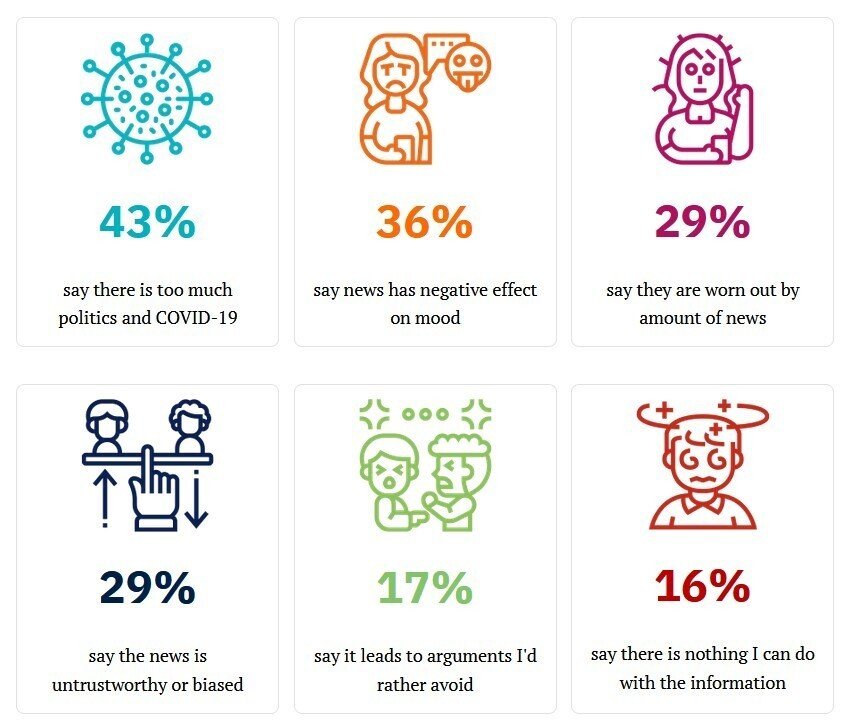
情報の真偽を確かめるにも手間がかかる
前に、NHKのニュースに関する記事を書いた。
この記事の中で参照した、朝日新聞とNHK放送文化研究所(文研)の記事は、英国のロイタージャーナリズム研究所の2022年の報告書の内容を引用している。
朝日新聞とNHK放送文化研究所の記事を見比べて気がついたのだが、同じ調査項目の結果についての表記が異なっていた。
ではどのような理由でニュースを避けているのだろうか。22年の調査では、「政治や新型コロナウイルスなどの扱いが多すぎる(43%)」「気分に悪影響がある(36%)」、さらに「ニュースに疲れ果てている(29%)」などがあがる(「ニュースは信頼できない/偏向している(29%)」もあがるが、この問題は別の機会に検討したい)。一方、規模は大きくないものの「ニュースについていくのが難しい(8%)」と気になる要素もあがっている。
ニュースを避ける理由について尋ねたところ、政治や新型コロナなど特定の話題に偏っていると答える人が27%で最も多く、次いで、信頼できないが18%、気分に影響すると時間がないと答えた人はそれぞれ17%だった。またニュースを理解するのが難しいとの答えも8%あった。

ロイタージャーナリズム研究所の報告書のurlについて、両方の記事とも正確な記載がなかったが、おそらくこれだと思う(タイトル画像もここから引用)。
そのurlには、このように載っている。

この図の数字に従って、先の記事では、このように書いた。
ニュースを避ける理由は、「政治や新型コロナウイルスなどの扱いが多すぎる(43%)」「気分に悪影響がある(36%)」、さらに「ニュースに疲れ果てている(29%)」「ニュースは信頼できない/偏向している(29%)」「避けたい論争を引き起こす(17%)」「情報に対してできることが何もない(16%)」となっている。
朝日新聞の記事や、NHK放送文化研究所の記事に書かれた数字は、何の数字だろうか?
結論からいうと朝日新聞の数字は世界を対象とした調査結果であり、NHKのそれは、日本の調査結果だと思う(その詳細については末尾※を参照)。
ただ、NHKの記事は、世界のデータと、日本のデータとが混在していて、数字がどちらを指すのか不明瞭だった。
NHKの表の項目も、普通なら数字の大きい順番に並べるべきだが、変な並べ方である。また、NHKの記事の末尾に、NHK放送文化研究所発行「放送と調査」9月号のことが触れられているが、正しくは「放送研究と調査」である。
NHK放送文化研究所は、書いた後の確認もしないまま、不出来な原稿を公開している。
生成AIの回答は正しくないことがあるから、おかしいと思ったら、引用元や関連情報を見るべきだという意見がある。
しかし、このように同じ調査報告に基づいて書かれた記事でも、不正確な場合がある。今回は、外国語で書かれた報告書までたどったが、面倒なことである。
少なくとも公的機関が発表する文章は、正確であってほしい。
※NHKの記事の末尾に紹介された、NHK放送文化研究所発行「放送と調査」9月号にはこう書かれていた。
なぜニュースを避けたいと思うのか,複数回答で尋ねたところ,「政治や新型コロナなどのニュースが多すぎる」が 27%,「信頼できない/偏向している」が 18%,「時間がない」が 17%,「気分に悪影響がある」が 17%,「情報で自分が 何かできると思わない」が 14%,「昨今のニュースの量に辟易している」が 12%,「自分が避けたい議論につながる」が 9%,「ニュースについていくのが難しい」が 8% などであった。
世界平均では,「政治や新型コロナなどのニュースが多すぎる」が 43%,「気分に悪影響がある」が 36%,「昨今のニュースの量に辟易している」が 29%,「信頼できない/偏向している」が 29%となっていて,ロイター研究所は,政治や新型コロナなど特定のニュースを回避する傾向がうかがえるとして,これを「選択的ニュース回避 」(Selective News Avoidance)と呼んだ。
明記されていないが、この文章の前半は、日本の調査結果だと思われる。
It takes time to verify the authenticity of information.
I wrote an article about NHK news before.
The Asahi Shimbun and NHK Broadcasting Culture Research Institute (Bunken) articles referenced in this article cites a 2022 report from the Reuters Institute for Journalism in the UK.
Both articles didn't have the exact URL for the report, but I think it's probably this one (the title image is also taken from here).
Comparing the articles of the Asahi Shimbun and the NHK Broadcasting Culture Research Institute, I noticed that the results of the same survey items were written differently.
What are your reasons for avoiding the news?
In a 2022 survey, 43% of respondents said that there was too much talk about politics and the novel coronavirus, that 36% had an adverse effect on their mood, and 29% said that they were exhausted by the news. (“News is unreliable/biased (29%)” also raised, but I would like to discuss this issue on another occasion). On the other hand, although the scale is not large, there is also an element of concern that it is difficult to keep up with the news (8%).
When asked about their reasons for avoiding the news, 27% of respondents said that they were biased towards specific topics such as politics and the novel coronavirus, followed by 18% who said they were unreliable, and 18% who said that it affected their mood and they did not have time. were 17% each. Eight percent also said they had difficulty understanding the news.
The original Reuters Institute for Journalism report puts it this way:
According to the numbers in this figure, I wrote in the previous article as follows.
The reasons for avoiding the news were "Too much about politics and the coronavirus (43%)," "It affects my mood (36%)," and "I'm exhausted from the news (29%)." are untrustworthy/biased (29%), cause controversy to avoid (17%), and have nothing to do with the information (16%).
What are the numbers written in the Asahi Shimbun article and the NHK Broadcasting Culture Research Institute article?
In conclusion, I think the Asahi Shimbun figures are the results of a global survey, and the NHK figures are the results of a Japanese survey (see the end for details *).
However, the NHK article mixed data from around the world with data from Japan, and it was unclear which one the numbers were referring to.
The items in the NHK table should normally be arranged in descending order of numbers, but this is a strange arrangement.
Also, at the end of the NHK article, the September issue of "The NHK Monthly Report on Broadcast research" published by NHK Broadcasting Culture Research Institute is mentioned, but the name of it was wrong.
I think that NHK Broadcasting Culture Research Institute published the unsuccessful manuscript without checking it after writing it.
There is an opinion that the answer of the generated AI may not be correct, so if you think something is wrong, you should look at the citation source and related information. But even articles like this based on the same research report can be inaccurate. This time, I traced the report written in a foreign language, but it is troublesome.
At the very least, I hope that the statements published by public institutions are accurate.
*In the September issue of "Broadcasting and Research" published by NHK Broadcasting Culture Research Institute, which was introduced at the end of the NHK article, it was written as follows.
When asked why they want to avoid news with multiple answers, 27% answered "too much news about politics and the new coronavirus," 18% said "unreliable/biased," and "I don't have time." 17% said that it had a negative effect on their mood, 17% said that they had an adverse effect on their mood, 14% said that they did not think they could do anything with the information, 12% said that they 9% answered that it would lead to discussions they wanted to avoid, and 8% answered that it was difficult to keep up with the news.
Globally, 43% said that there was too much news about politics and the novel coronavirus, 36% said that it had an adverse effect on their mood, 29% said that they were tired of the amount of news these days. unreliable/biased” was 29%.
The Reuters Institute called this "selective news avoidance," citing a tendency to avoid certain news, such as politics and the novel coronavirus.
Although it is not specified, the first half of this sentence seems to be the result of a Japanese survey.
この記事が気に入ったらサポートをしてみませんか?
